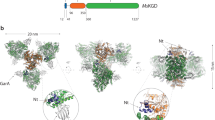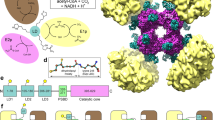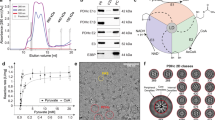Abstract
Enzymes that use the cofactor thiamin diphosphate (ThDP, 1), the biologically active form of vitamin B1, are involved in numerous metabolic pathways in all organisms. Although a theory of the cofactor's underlying reaction mechanism has been established over the last five decades1,2, the three-dimensional structures of most major reaction intermediates of ThDP enzymes have remained elusive. Here, we report the X-ray structures of key intermediates in the oxidative decarboxylation of pyruvate, a central reaction in carbon metabolism catalyzed by the ThDP- and flavin-dependent enzyme pyruvate oxidase (POX)3 from Lactobacillus plantarum. The structures of 2-lactyl-ThDP (LThDP, 2) and its stable phosphonate analog, of 2-hydroxyethyl-ThDP (HEThDP, 3) enamine and of 2-acetyl-ThDP (AcThDP, 4; all shown bound to the enzyme's active site) provide profound insights into the chemical mechanisms and the stereochemical course of thiamin catalysis. These snapshots also suggest a mechanism for a phosphate-linked acyl transfer coupled to electron transfer in a radical reaction of pyruvate oxidase.
This is a preview of subscription content, access via your institution
Access options
Subscribe to this journal
Receive 12 print issues and online access
$259.00 per year
only $21.58 per issue
Buy this article
- Purchase on Springer Link
- Instant access to full article PDF
Prices may be subject to local taxes which are calculated during checkout




Similar content being viewed by others
Change history
30 May 2006
supp info PDFs 1 and 2 replaced; compound numbering fixed; notes added to HTML
Notes
*Note: In the supplementary information initially published online to accompany this letter, the legends of Supplementary Figures 1 and 2 are incorrect. The legends contain incorrect citations to other figures; Supplementary Figure 1 should cite Fig. 3a and Supplementary Figure 2 should cite Supplementary Fig. 3. These errors have been corrected online. Also, in the version of this article initially published online, compounds in the Compound Data Index are listed in the wrong order; thus the numbered compounds in the article link to the wrong structures. This error has been corrected in the HTML version of the article.**Note: In the version of this article initially published, there was an error in the text of the second page. In line 15 of the first column, the text should read "a difference Fourier" rather than "a distance Fourier." The error has been corrected in the PDF version of the article.
References
Schowen, R.L. Thiamin-dependent enzymes. in Comprehensive Biological Catalysis Vol. 2 (ed. Sinnot, M.) 217–266 (Academic, London, 1998).
Kluger, R. Thiamin diphosphate: a mechanistic update on enzymic and nonenzymic catalysis of decarboxylation. Chem. Rev. 87, 863–876 (1987).
Muller, Y.A. & Schulz, G.E. Structure of the thiamine- and flavin-dependent enzyme pyruvate oxidase. Science 259, 965–967 (1993).
Kern, D. et al. How thiamine diphosphate is activated in enzymes. Science 275, 67–70 (1997).
Tittmann, K. et al. NMR analysis of covalent intermediates in thiamin diphosphate enzymes. Biochemistry 42, 7885–7891 (2003).
Nemeria, N. et al. Tetrahedral intermediates in thiamin diphosphate-dependent decarboxylations exist as a 1′,4′-imino tautomeric form of the coenzyme, unlike the Michaelis complex or the free coenzyme. Biochemistry 43, 6565–6575 (2004).
Lindqvist, Y., Schneider, G., Ermler, U. & Sundstrom, M. Three-dimensional structure of transketolase, a thiamine diphosphate-dependent enzyme, at 2.5 A resolution. EMBO J. 11, 2373–2379 (1992).
Arjunan, P. et al. Crystal structure of the thiamin diphosphate-dependent enzyme pyruvate decarboxylase from the yeast Saccharomyces cerevisiae at 2.3 A resolution. J. Mol. Biol. 256, 590–600 (1996).
Arjunan, P. et al. Structure of the pyruvate dehydrogenase multienzyme complex E1 component from Escherichia coli at 1.85 A resolution. Biochemistry 41, 5213–5221 (2002).
Fiedler, E. et al. Snapshot of a key intermediate in enzymatic thiamin catalysis: crystal structure of the alpha-carbanion of (alpha,beta-dihydroxyethyl)-thiamin diphosphate in the active site of transketolase from Saccharomyces cerevisiae. Proc. Natl. Acad. Sci. USA 99, 591–595 (2002).
Chabriere, E. et al. Crystal structure of the free radical intermediate of pyruvate:ferredoxin oxidoreductase. Science 294, 2559–2563 (2001).
Tittmann, K. et al. Radical phosphate transfer mechanism for the thiamin diphosphate- and FAD-dependent pyruvate oxidase from Lactobacillus plantarum. Kinetic coupling of intercofactor electron transfer with phosphate transfer to acetyl-thiamin diphosphate via a transient FAD semiquinone/hydroxyethyl-ThDP radical pair. Biochemistry 44, 13291–13303 (2005).
Gruys, K.J., Halkides, C.J. & Frey, P.A. Synthesis and properties of 2-acetylthiamin pyrophosphate: an enzymatic reaction intermediate. Biochemistry 26, 7575–7585 (1987).
Kluger, R. & Pike, D.C. Active site generated analogs of reactive intermediates in enzymic reactions. Potent inhibition of pyruvate dehydrogenase by a phosphonate analog of pyruvate. J. Am. Chem. Soc. 99, 4505–4506 (1977).
Jordan, F., Li, H. & Brown, A. Remarkable stabilization of zwitterionic intermediates may account for a billion-fold rate acceleration by thiamin diphosphate-dependent decarboxylases. Biochemistry 38, 6369–6373 (1999).
Arjunan, P. et al. A thiamin-bound, pre-decarboxylation reaction intermediate analogue in the pyruvate dehydrogenase E1 subunit induces large-scale disorder-to-order transformations in the enzyme and reveals novel structural features in the covalently bound adduct. J. Biol. Chem. (in the press) (2006).
Dunathan, H.C. Stereochemical aspects of pyridoxal phosphate catalysis. Adv. Enzymol. 35, 79–134 (1971).
Kluger, R. & Smyth, T. Thiamin-catalyzed decarboxylation of pyruvate. Synthesis and reactivity analysis of the central, elusive intermediate, alpha-lactylthiamin. J. Am. Chem. Soc. 103, 884–888 (1981).
Jordan, F. & Nemeria, N. Experimental observation of thiamin diphosphate-bound intermediates on enzymes and mechanistic information derived from these observations. Bioorg. Chem. 33, 190–215 (2005).
Zhang, S. et al. Evidence for dramatic rate acceleration of an C-H bond ionization rate in thiamin diphosphate enzymes by the protein environment. Biochemistry 44, 2237–2243 (2005).
Wille, G. et al. The role of Val-265 for flavin adenine dinucleotide (FAD) binding in pyruvate oxidase: FTIR, kinetic, and crystallographic studies on the enzyme variant V265A. Biochemistry 44, 5086–5094 (2005).
Otwinowski, Z. & Minor, W. Processing of X-ray diffraction data collected in oscillation mode. Methods Enzymol. 276A, 307–326 (1997).
Collaborative Computational Project Number 4. The CCP4 suite: programs for protein crystallography. Acta Crystallogr. D50, 760–763 (1994).
Emsley, P. & Cowtan, K. Coot: model-building tools for molecular graphics. Acta Crystallogr. D 60, 2126–2132 (2004).
Acknowledgements
We gratefully acknowledge access to synchrotron radiation beamlines X13 and BW7B at the European Molecular Biology Laboratory outstation, Deutsches Elektronen-Synchrotron, Hamburg. We thank R. Schowen, R. Kluger, S. Ghisla, F. Jordan and in particular G. Hübner for many stimulating discussions.
Author information
Authors and Affiliations
Corresponding authors
Ethics declarations
Competing interests
The authors declare no competing financial interests.
Rights and permissions
About this article
Cite this article
Wille, G., Meyer, D., Steinmetz, A. et al. The catalytic cycle of a thiamin diphosphate enzyme examined by cryocrystallography. Nat Chem Biol 2, 324–328 (2006). https://doi.org/10.1038/nchembio788
Received:
Accepted:
Published:
Issue Date:
DOI: https://doi.org/10.1038/nchembio788
This article is cited by
-
Ground-state destabilization by electrostatic repulsion is not a driving force in orotidine-5′-monophosphate decarboxylase catalysis
Nature Catalysis (2022)
-
Characterisation of plasmodial transketolases and identification of potential inhibitors: an in silico study
Malaria Journal (2020)
-
Low-barrier hydrogen bonds in enzyme cooperativity
Nature (2019)
-
Crystal structures of archaeal 2-oxoacid:ferredoxin oxidoreductases from Sulfolobus tokodaii
Scientific Reports (2016)
-
Acetohydroxyacid synthases: evolution, structure, and function
Applied Microbiology and Biotechnology (2016)



